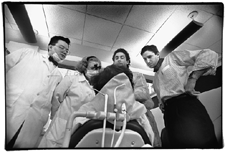Main Menu · Search · Current Issue · Contact · Archives · Centennial · Letters to the Editor · FAQs
![]()
Main Menu · Search · Current Issue · Contact · Archives · Centennial · Letters to the Editor · FAQs
![]()
| Commencement Day, 1996 | Medical Dean |
| Money Maven | Hail, Fellow! |
| New Pathway Extended | Seeger of Truth |
| Heard at Harvard | The Undergraduate |
| Crimson on the Tube | Sports |
| Phillips Brooks House | The University |

![]()
At Harvard, medical and dental students have the same coursework and are evaluated by identical rules during their first two years of study. They all experience the New Pathway program (see "M.D. to Be," March-April, page 66). This approach to learning is based on the idea that students may be best trained not by lecturing at them, but by presenting them with a carefully constructed case-a problem-and tutoring them as they work together in small groups to identify the issues of the case and to discover what they need to know to address them. At that point, perhaps, a professor lectures, when the students have taught themselves the questions and are eager for answers. The problem-based curriculum was a clear success from the moment it was introduced in 1987.
After their first two years, Harvard's dental students have gone on to three years of traditional, discipline-based, clinical instruction. Lately, they have demanded change. "Our students say that encountering the traditional approach to clinical training after two years of the New Pathway is like hitting a brick wall," says Karl S. Matlin, associate professor of medicine and director of curriculum development at the School of Dental Medicine. The wall came down in June. Now, the clinical phase of dental training will be problem based, and it will require two years, not three.
Heretofore, clinical instruction has brought a variety of faculty members to lecture to students about their specialties, one after another-periodontics, endodontics, pediatric dentistry, and so on. Patients have come into the clinic for treatment only on the days when the dental malady they represented was under discussion. "It's almost been, if this is Wednesday, it must be perio day," says Matlin. "This approach fragments the way a student learns to treat dental disease. It's not holistic. It has a tendency to cause a student to look at a patient as a technical or procedural problem, not as a person. And it can waste time by duplicating instruction if a clinical procedure is common to more than one specialty."
Henceforth, the 30 or so dental students in each class will form teams of seven or eight. A "senior tutor," with ultimate responsibility for the clinical instruction of the students and for the treatment of the patients, will head each team. Students will take a series of five interdisciplinary courses during each year. Patients will come to the clinic for the comprehensive treatment of all dental-disease problems they may have, and the same team will see them on each of their visits.
"With problem-based learning, the students and their tutors deal with the whole person," says Matlin. "Your perspective turns around. You're not taking a course to learn a particular skill. You're treating a patient and therefore need a certain skill."
Main Menu · Search · Current Issue · Contact · Archives · Centennial · Letters to the Editor · FAQs
![]()
Harvard Magazine · 7 Ware Street · Cambridge, MA 02138 · Phone (617) 495-5746